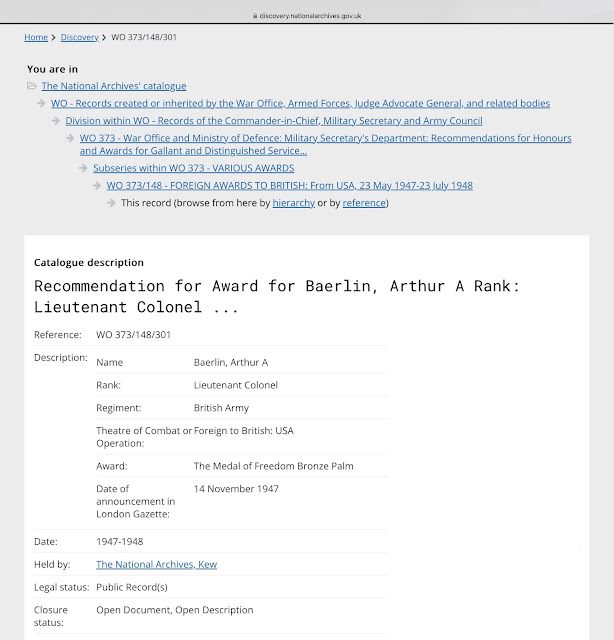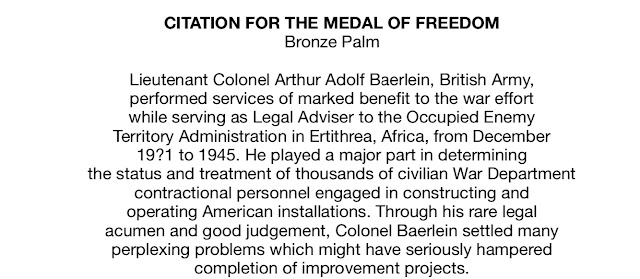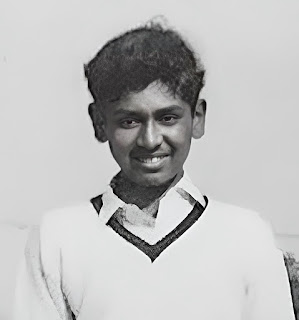CHARNEY HALL A A Baerlein
Post updated 22 June ‘25 : Citation for Medal of Freedom (Bronze Palm)
Lieutenant-Colonel, The Honourable Arthur Adolph Baerlein CBE, Medal of Freedom with Bronze Palm.
The family of Arthur Adolph Baerlein (b. 27 Nov 1886, d. 27 Jan 1966) (CH 1900-01) were ‘Manchester textile merchants, machine exporters, dealers in cotton and flax waste, shipping agents, converters, spinners and doublers’*. His grandfather Emanuel, originally from Furth, Bavaria had established a yarn merchants and his sons Max and Sigismund joined the business, initially operating from 18 Exchange Street, Salford.
Baerleins also supplied their own Lancashire looms to the mills of East Lancashire and Manchester which were manufactured by Atherton Brothers of Preston.
Max Baerlein married Emily Cohen from Rusholme in 1876. Their first house was The Limes, Eccles Old Road, Pendleton, Salford, where they started their family, and latterly The Grange in Withington where at one point in 1891 they employed 7 servants*.
In 1877 the Baerleins bought a plot of land at auction from Salford Corporation and in the following two years commissioned and erected ‘The Baerlein Building’, which contained new offices and a warehouse for their businesses, proudly advertising its completion and occupation in September 1879**.
Arthur Baerlein was Max and Emily’s third son who appeared in the 2nd Set at Charney Hall in 1900. His younger brother, Oswald Felix, their 5th and last child was to follow him in 1905-1906.
Arthur Baerlein then attended Sedbergh School between 1902-1903.
He was admitted as a barrister-at-law on 6 June 1910 and subsequently called to the Bar on 16 April 1913 when he was 25 years old.
In WW1 Arthur was registered in Jan 1915 as Special Reserve, 2nd Lieutenant in the Royal Field Artillery of the British Army but by April 1918 he had been transferred to 16 Squadron RAF as an observer. Arthur had, like Euan Rabagliati after him, opted to join those courageous men who in their flimsy flying machines ventured over enemy lines under fire to photograph, observe and report back to headquarters on troop movements and artillery positions.
Cpt. Ewart James Garland’s diary describes life in the air in the month of April 1917 on the Western Front**. Arthur flew with him regularly as his observer. However on one sortie they were not in the same aeroplane and Cpt. Garland must have seen Baerlein’s ‘plane go down as he wrote that he had been killed. But fortunately Arthur had survived and was taken prisoner by the Germans. It was later confirmed that he had been captured on 28 April.
‘More bad news – Mason and Baerlein have been killed – that leaves Durham and I out of the eight who were posted to 16 Squadron. If we had not been posted back here there is little (chance) we would have been done in. Pearson has come back as a pilot – it is great to see an old face again’
Arthur was wounded in 1917 and was eventually repatriated as a casualty to Britain on 25 December 1918. He was discharged from the RAF after the cessation of hostilities drawing an end to the Great War on 1 March 1919.
In May 1919 he was mentioned in despatches (MiD) for attempting to escape from captivity which he did unsuccessfully several times.
In the inter-war period Arthur appears to have returned to the law. Life was not all work as in 1921 he reached the semi-finals of the Bar Golfing Society played at Rye, East Sussex.
In WW2 he was ranked as 2nd lieutenant and ‘acting major’ on the General List. This was a holding unit for specialist officers who had not been assigned to a unit. After the end of war he was awarded the American Medal of Freedom with Bronze Palm ****. The list shows that he was an acting lieutenant-colonel at the time.
He is recorded as being registered in the Inner and Middle Temple, City of London, Westminster between 1953-1959.
In 1958 Lieutenant-Colonel The Honourable A A Baerlein is listed as a Representative Member of the Legislative Council for the Protectorate of Uganda.
He was awarded the CBE in June 1959 for public services in Uganda.
He was also a member of the Constitutional Committee entrusted in bringing about Uganda’s Independence perhaps the greatest achievement of his life ***. Uganda gained independence from the UK on 9 October 1962.
Thereafter between the dates of 17 June 1965 - 27 January 1966 he acted as a judge of the High Court (in Uganda).
Arthur Adolph Baerlein died at the age of 79 in Jinja, Uganda at 3a Nile Crescent near the shore of Lake Victoria on 27 January 1966 before he was able to retire.
.
* https://ecclesoldroad.uk/person/max-baerlein/
***Proceedings of the Legislative Council (Uganda): Official Report 1966.
****The Medal of Freedom was produced in 1945 ‘as an award for non-members of the United States Armed Forces who had performed meritorious deeds or service in aiding the United States of America in the prosecution of the war against an enemy or enemies and for which an award of another US medal or decoration is considered inappropriate’.
Credit : The National Archives










Comments